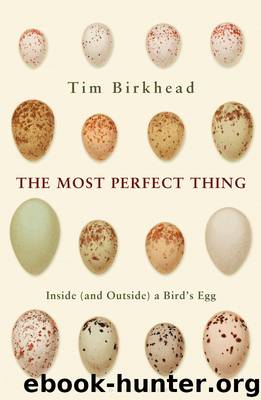The Most Perfect Thing by Tim Birkhead

Author:Tim Birkhead
Language: eng
Format: epub
Publisher: Bloomsbury Publishing
Published: 2015-04-09T16:00:00+00:00
And what of guillemots? In my mind’s eye I can see George Lupton at the end of each day returning to his Bridlington boarding house to examine his haul of eggs. I can also sense his euphoria as he holds that season’s Metland egg in his hands and feasts his eyes on its colourful surface. Judging from the muck on the outside, the egg has been incubated for a couple of days, but Lupton wipes away any trace of the egg’s previous life with a damp cloth. By arrangement with his landlady, he’s at the kitchen table with an empty dish and a bowl full of water and his egg drills laid out like a surgeon’s implements in front of him. Each drill is a fluted, cone-shaped metal contraption, rather like an elongated version of the device joiners use to countersink screws. Picking up the first egg, Lupton looks for a point at which he can penetrate the egg’s surface. As the spike bites, and as Lupton twizzles the drill gently between his finger and thumb, there’s a soft fall of snow-like calcium carbonate on to the table. Lupton pushes, turning the drill harder until he feels it ‘give’ as he breaks through the inner shell membrane and the drill becomes wet with albumen.
He twists the drill back and forth a few times to produce a perfectly symmetrical circular hole about six millimetres in diameter. Every collector has his own way of doing this and perfection is part of the process. Lupton then takes his brass blowing tube, bent almost at right angles, and, placing the narrow end just at the entrance of the hole he’s made, he puts the other wider end into his mouth. Positioning the egg over the empty dish with the hole in the egg facing downwards, he proceeds to blow. As anyone knows who has done this, blowing out the contents of an egg takes some effort. With Louis Armstrong cheeks and bulging eyes, Lupton forces the ice blue albumen from the hole. The different fractions of albumen come in fits and starts: the outermost liquid fraction runs out easily, almost like water; the dense viscous fraction resists until the last moment and then splutters out like a noisy fart, but some of it sticks and Lupton has to use his fingers to pull it free. With a final exhalation of relief the globules that contain the chalazae emerge. Then, slowly and serenely comes the yolk: a continuous, opaque golden stream running smoothly into the bowl. Almost the last to appear is the germinal disc, a tiny speck among the yolk whose red threads are the beginnings of the ‘placental’ blood vessels. Seeing this confirms what Lupton already suspected: this was an egg laid almost as soon as the previous collection was complete, for it has clearly been incubated for two or three days. A fresher egg would have had no sign of development.
Lupton finishes by flushing the interior of the shell several times with water.
Download
This site does not store any files on its server. We only index and link to content provided by other sites. Please contact the content providers to delete copyright contents if any and email us, we'll remove relevant links or contents immediately.
| Birds | Fish |
| Flowers | Insects & Spiders |
| Mammals | Regional |
| Reptiles & Amphibians | Rocks & Minerals |
| Stars & Planets | Trees |
Photographic Guide to the Birds of Indonesia by Strange Morten;(2408)
The Big Twitch by Sean Dooley(2319)
7-14 Days by Noah Waters(2249)
Identifying Birds by Colour by Norman Arlott(2137)
Tippi by Tippi Hedren(2100)
Birds of the Pacific Northwest by Shewey John; Blount Tim;(1876)
Raptors by Traer Scott(1544)
The Path Between the Seas by David McCullough(1511)
Bald Eagles In the Wild by Jeffrey Rich(1423)
Life on Earth by David Attenborough(1372)
Skin by Unknown(1300)
How to Speak Chicken by Melissa Caughey(1267)
Nest by Janine Burke(1217)
The Feather Thief by Kirk Wallace Johnson(1197)
Life List by Olivia Gentile(1133)
Birds of New York City by Cal Vornberger(1129)
H Is for Hawk by Helen Macdonald(1122)
RSPB Pocket Guide to British Birds by Simon Harrap(1098)
The Peregrine by J. A. Baker(1062)
